Hunters have debated the pros and cons of Blackhorn 209 vs 777 vs Goex black powder for years. Each propellant has different strengths and weaknesses, but which one should you be hunting with?
Especially if you’re new to the muzzleloader world, I think you’ll agree with me when I say that choosing the right propellant for your muzzleloader can be an overwhelming experience due to the sheer number of options available.
I struggled with the same problem when I first got started hunting with a muzzleloader many years ago. Since then I’ve tried almost all of the big brands (Blackhorn 209, Pyrodex, Hodgon’s 777, Goex, etc.) as well as the different variations of each propellant (pellets vs powder). Some worked better for me than others, but I’ve also gained a lot of insight into the strengths and weaknesses of the various propellants under different conditions.
In this post, I’m going to share the results of a head-to-head assessment I recently made comparing Blackhorn 209 vs 777 vs Goex black powder under controlled conditions to help you decide which one you should be hunting with in your muzzleloader.
Before we begin, I have three disclaimers.
First, the links below to Muzzle-Loaders.com (as well as the links to Amazon) are affiliate links. This means I will earn a small commission if you make a purchase.
This commission comes at no extra cost to you. This helps support the blog and allows me to continue to create free content that’s useful to hunters like yourself.
Second, Muzzle-Loaders.com provided the powder, primers, bullets, and the CVA Optima (they sent it to me several years ago for this article) that I used during my range session.
Third, I am not a gunsmith or a chemist. Use the powders discussed below in accordance with the manufacturer’s instructions and only shoot them in a muzzleloader that is in good condition. The information on this site is for informational and entertainment purposes only. By using this site you agree to hold me harmless from any ramifications that occur to you as a result of acting on information found on this site.
Now that we’ve got that out of the way, let’s get started.
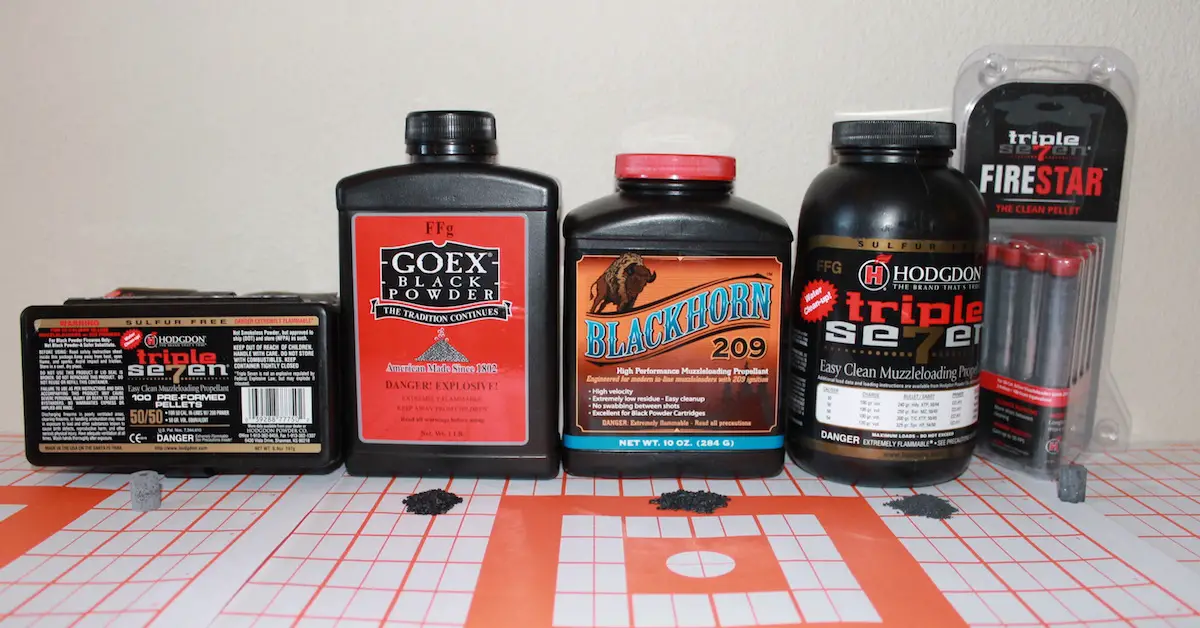
Blackhorn 209 vs 777 vs Goex Black Powder: Comparison
Since Hodgon’s 777 and Blackhorn 209 are two of the most popular black powder substitutes hunters use these days (check out this article for a more detailed discussion of popular black powder substitutes), I decided to do a comparison to see how they stack up next to each other. I’ve also wondered how much difference in performance there is (if any) between loose FFg 777 and the 50gr and 33gr pellets. Additionally, I was also curious to see how Blackhorn 209 and Hodgon’s 777 compare to regular Goex FFg black powder.
So, with all that in mind, I spent a long day at the range trying to answer those questions.
During my test, I shot 5 shots using a 100gr load and 5 shots of a “max” load of each propellant and measured the muzzle velocity with my Pro Chrono chronograph. I used CCI 209M primers (check out this article for a more detailed discussion of popular muzzleloader primers) in my CVA Optima muzzleloader (which has a 26″ barrel) and shot 250gr PowerBelt AeroLite bullets. All the loads I compared were measured by volume (not mass).
Since they are produced in 50gr increments, I shot 100gr and 150gr loads of the 50gr 777 pellets. Likewise, I shot 100gr (3 pellets) and 165gr (5 pellets) loads of the Hodgons’ 777 FireStar pellets. Use all of these loads (but particularly the 5 pellet FireStar load) at your own risk and absolutely DO NOT shoot that FireStar load in a muzzleloader that is not rated for 150gr of standard powder (here’s Hodgdon’s official 3, 4, and 5 FireStar pellet load data).
For everything else, I shot a 100gr and a 120gr load of powder measured by volume.
Blackhorn 209 vs 777 vs Goex Black Powder: Performance
The final results of my Blackhorn 209 vs 777 vs Goex Black Powder comparison are in the table below.
Keep in mind that these are the results I obtained using the parameters I discussed above under the specific conditions I experienced at the range that day. You will very likely get somewhat different results by shooting different bullets, using a different muzzleloader, etc.
Even so, the results I obtained should still serve as a reasonable guide for how the different propellants stack up next to each other.
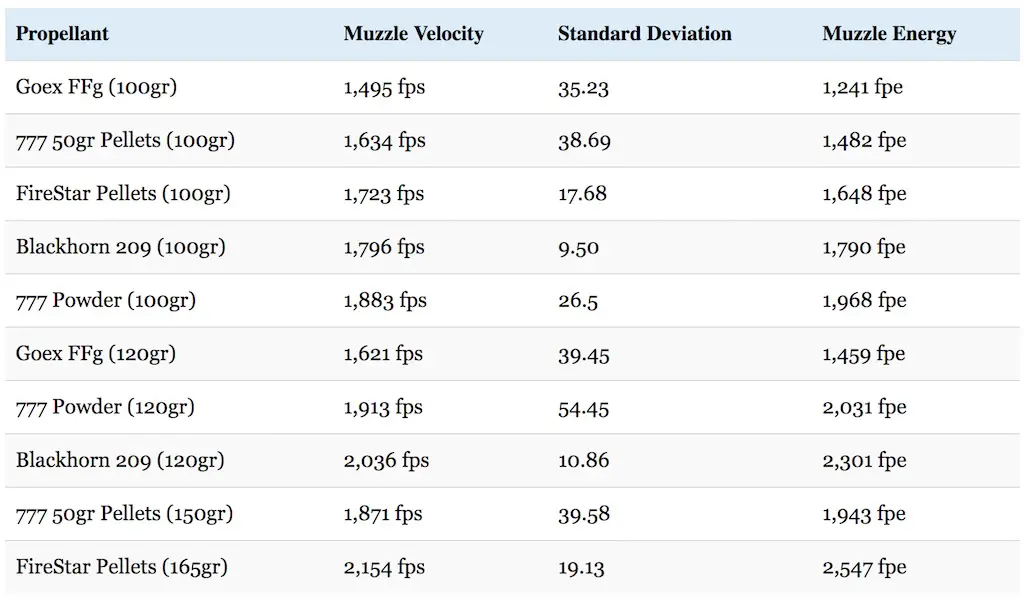
As you can see, every single Blackhorn 209 and 777 load produced higher velocities (150-500fps) than comparable loads using Goex black powder.
The Goex black powder was also the dirtiest propellant I used in this test by a long stretch.
777 (of all types) was better, but still relatively dirty with the 777 FireStar pellets producing the least fouling of the bunch. Blackhorn 209 produced significantly less fouling than both the 777 and Goex black powder.
At the same time, the Blackhorn 209 and loose 777 loads were comparable in performance with a difference of approximately 100fps in average velocity.
However, both Blackhorn 209 loads had BY FAR the smallest standard deviation out of any load tested. Since standard deviation quantifies the amount of variation in a data set, this means that Blackhorn 209 produced the most consistent velocities.
By the same token, the loose 777 loads had a higher average velocity than comparable loads using the 33gr and 50gr pellets. Indeed, I got higher velocities using 120gr of loose 777 than I did with 150gr of 777 pellets.
However, at 2,154fps, the 165gr (5 pellets) Hodgon’s 777 FireStar load had the highest average velocity I measured during the test. The overall performance of the 777 FireStar pellets matched up well with Hodgon’s claims of producing higher velocities with less fouling than other 777 pellets. They also had the smallest variation in velocity out of every load I tested except for the Blackhorn 209 loads.
Why?
Well, the 33gr 777 FireStar pellets have a star shape as opposed to the cylindrical shape of the 50gr 777 pellets. Hodgon’s claims that the different shape provides more surface area for ignition. While I’m sure that had something to do with the difference in performance between the two different types of pellets, there are likely other factors at play here as well.
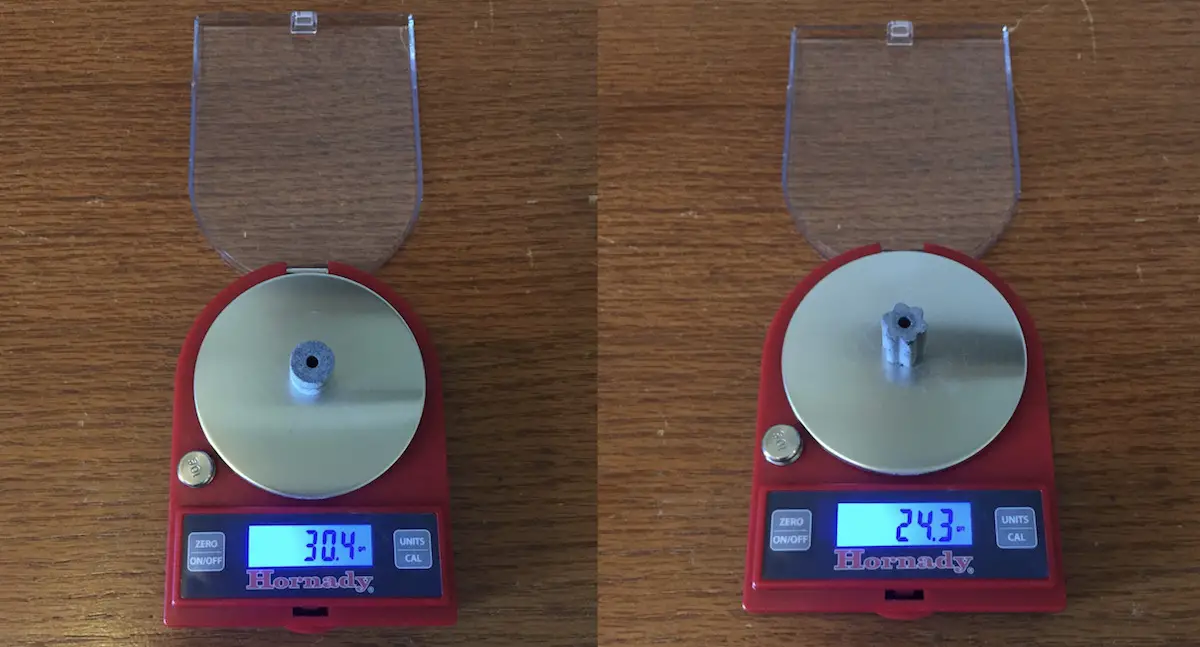
Out of curiosity, I individually weighed a 20 pellets of each type on my Hornady G2 1500 scale. On average, the 50gr pellets weighed 30.375gr each with a standard deviation of .353. The 33gr FireStar pellets weighed 24.318gr each with a standard deviation of .098.
So, it follows that a 100gr charge of 2x 50gr pellets weighs an average of 60.75gr and a 100gr charge of 3x 33gr FireStar weighs 72.95gr.
This data does match up reasonably well with the results I obtained from measuring the velocity of each propellant: the 100gr charge of FireStar pellets pushed those 250gr bullets at a higher average velocity with a smaller standard deviation than the 100gr charge of 50gr 777 pellets.
Like I said earlier, I acknowledge that there are factors involved here than just the weight of the pellets. For comparison, 100gr by volume of loose 777 powder weighs right at 70gr. The 100gr load of 777 powder produced velocities over 150fps higher than the 100gr load of FireStar pellets, so there are clearly differences in performance related to the burn characteristics of loose 777 vs 777 pellets as well.
Anyway, that’s just something to keep in mind.
Blackhorn 209 vs 777 vs Goex Black Powder: Which Is Right For You?
So what does it all mean?
Picking the right propellant out of the three really depends on your personal desires and what sort of muzzleloader you’ll be hunting with.
Black powder is much easier to ignite than substitutes like 777 or Blackhorn 209. So, if you use a flintlock or sidelock muzzleloader, you’ll almost certainly need to use some sort of true black powder like Goex since those types of muzzleloaders have relatively weak ignition systems.
Blackhorn 209 is definitely out because it requires a 209 primer for reliable ignition. The same goes for 777 pellets. While it probably won’t work in a flintlock, some hunters and shooters have had success using loose 777 powder in sidelock muzzleloaders, particularly those using a musket cap as opposed to a #11 cap. If you can get it to work for you, then great.
You’ll probably still need to use regular ol’ black powder to avoid hangfires and misfires though.
If you have an inline muzzleloader restricted to using musket caps (like the CVA Wolf Northwest), then Blackhorn 209 is probably still out, but you can probably use loose 777. You’ll just have to try and see how it works for you.
Now, if you use an inline muzzleloader and 209 primers, then you’ll very likely get reliable ignition using any of the major brands of black powder or black powder substitutes.
Accuracy of varying charges of different propellants will differ from muzzleloader to muzzleloader though. The only way to find out for sure is to spend some time at the range and see which load shoots best in your particular muzzleloader.
That being said though, Blackhorn 209 is probably your best bet for the greatest all around performance.
Like I said earlier, Blackhorn 209 produced by far the most consistent velocities in my test. Consistency is very important for accuracy and using a powder charge that produces almost exactly the same velocity each time will really help in that regard. The fact that Blackhorn 209 also leaves less fouling in the barrel not only makes it easier to clean, but it also helps accuracy when taking multiple shots in a row since there isn’t as much variation in the amount of fouling in the barrel.
Honestly, the differences in velocity between the various Blackhorn 209 and 777 loads were not big enough to make a gigantic difference afield. Yes, the 120gr load of Blackhorn 209 has a slightly flatter trajectory than the 120gr load of 777 powder, but it’s a small enough improvement that it should not outweigh other concerns you should keep in mind when choosing a propellant like accuracy, cost, availability, reliable ignition, etc.
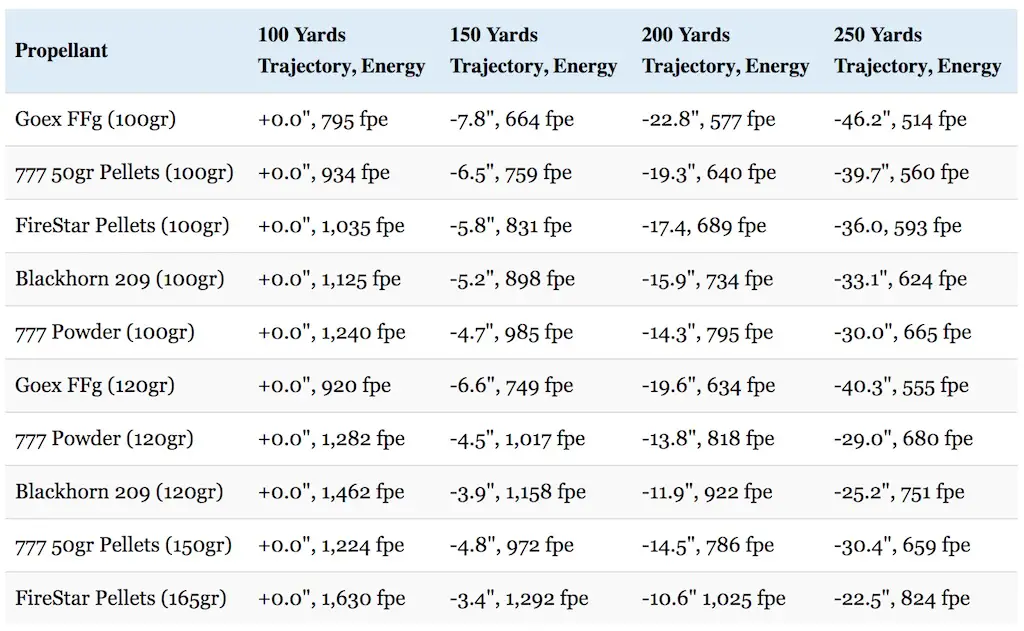
On the other hand, there is a big difference in performance between Goex black powder on one hand, and 777/Blackhorn 209 on the other. If at all possible, I recommend using either of the black powder substitutes so you can take advantage of the step up in performance they provide compared to black powder. They are also generally a lot easier to obtain than black powder.
Don’t get me wrong: black powder will certainly do the job for hunting many species of big game. However, you’ll just have to be a little more selective with your shots.
Additionally, you should keep the pros and cons of using 777 pellets in mind as well.
First off, pellets are A LOT faster and easier to load than loose powder.
That being said, the 50gr pellets consistently shot the same bullet at lower velocities with a higher standard deviation than comparable loads of loose powder. This corresponds to a more arching trajectory and degraded accuracy.
On the other hand, there was a big difference in performance between the 50gr 777 pellets and the 777 FireStar pellets.
The FireStar pellets shot at higher velocities and had some of the lowest standard deviations out of every load I shot. Additionally, the 165gr 777 FireStar load also had the highest velocity in the test.
So, should you use pellets or loose powder?
If you’re using 209 primers that will reliably ignite whatever propellant you choose to use, the choice of pellets vs powder all boils down to your specific situation.
Though you’ll generally (but not always) get better accuracy and higher velocities using loose powder, it’s probably not enough to make a significant difference at short range. For that reason, hunters who aren’t concerned with making longer range shots are probably better off using pellets. If you decide to use 777 pellets, then the 33gr 777 FireStar pellets will probably work a little better for you than the 50gr pellets.
However, if you want to squeeze every bit of accuracy out of your muzzleloader, then you should probably use loose powder.
Why?
Using loose powder gives you the ability to tailor your load in smaller increments to find out the exact amount of powder that shoots your chosen muzzleloader bullet most accurately in your specific muzzleloader. For instance, I found that my CVA Optima shoots the 250gr PowerBelt AeroLite and 290gr Barnes T-EZ bullets most accurately using a 110gr load of Hodgon’s 777 powder.
That’s not an ironclad rule though. You’ll just need to shoot a couple different loads in your muzzleloader and see what performs best.
Just like with anything else, there is no such thing as a free lunch when it comes to choosing the right propellant for your muzzleloader. Unfortunately, there is no “best” choice and there are some significant differences in the performance characteristics of black powder and black powder substitutes (Blackhorn 209 vs Hodgdon’s 777 vs Goex black powder). Make sure you consider all the cost, availability, reliability of ignition, and potential accuracy of any propellant you choose and carefully evaluate how it will work in your specific situation.
While this post covers choosing the right propellant for your muzzleloader, that’s only part of the equation. For more detailed information on choosing the gear for hunting with a muzzleloader, check out these other articles:
9 Best Muzzleloader Scopes For Hunters
These Are The Best 9 Best Muzzleloader Sights For Hunters
9 Of The Best Muzzleloaders For Hunters
5 Best Traditional Muzzleloaders For Hunters
Essential Muzzleloader Supplies Every Hunter Needs
101 Best Gifts For Hunters To Put On Your Wish List
Enjoy this article discussing Blackhorn 209 vs Hodgdon’s 777 vs Goex Black Powder? Please share it with your friends on Facebook and Twitter.
Make sure you subscribe to The Big Game Hunting Podcast and follow The Big Game Hunting Blog on Facebook, Instagram, Twitter, and YouTube.
Endorsement Disclosure: Per the guidelines of the Federal Trade Commission, the product reviewed here is an endorsement and I received compensation by “in-kind” payment to review the product.
NEXT: POWERBELT BULLET REVIEW: 250gr AEROLITE vs 270gr PLATINUM
John McAdams is a proficient blogger, experienced shooter, and long time hunter who has pursued big game in 8 different countries on 3 separate continents. John graduated from the United States Military Academy at West Point and is a veteran of combat tours with the US Army in Iraq & Afghanistan. In addition to founding and writing for The Big Game Hunting Blog, John has written for outdoor publications like Bear Hunting Magazine, The Texas State Rifle Association newsletter, Texas Wildlife Magazine, & Wide Open Spaces. Learn more about John here, read some of John’s most popular articles, and be sure to subscribe to his show: the Big Game Hunting Podcast.

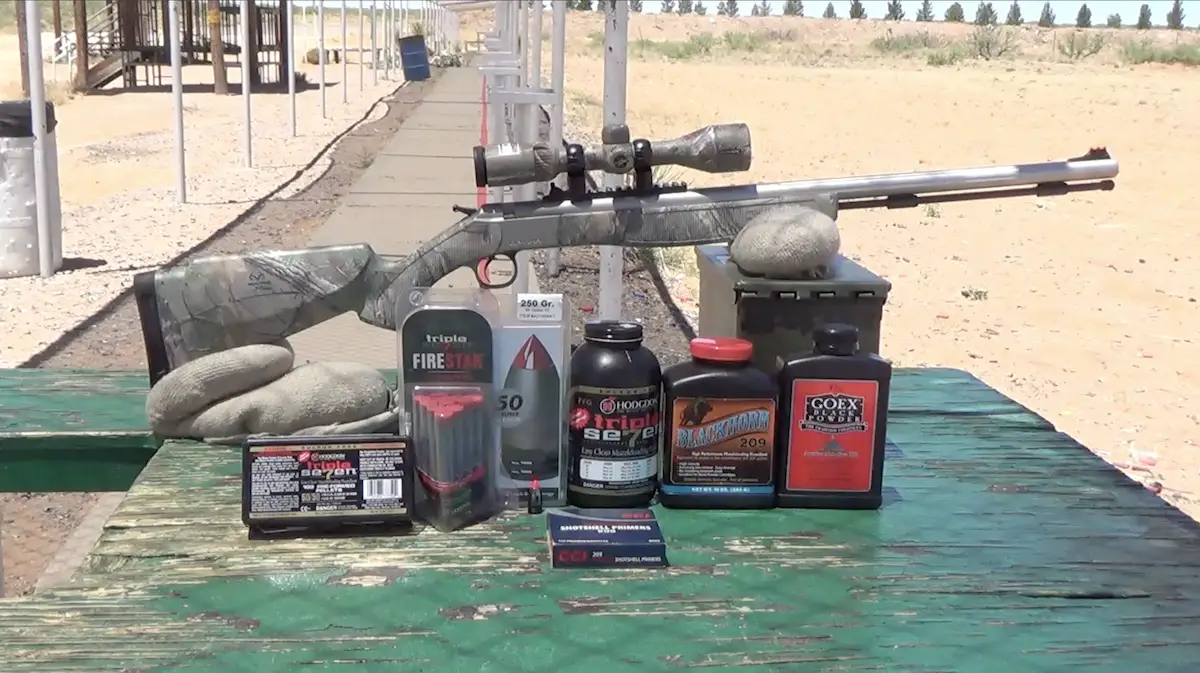
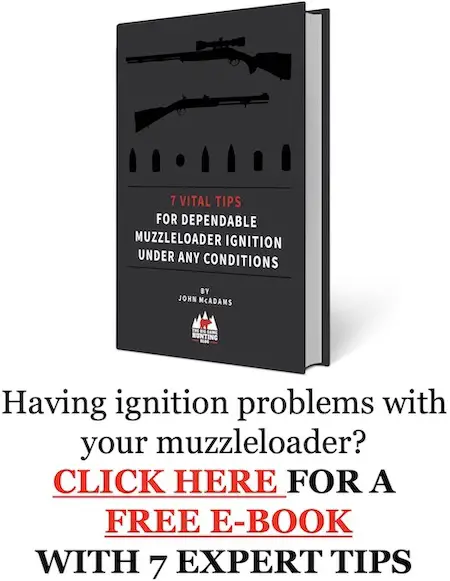
So… I get my best shots in my Traditions Vortex using 100 gr 777ffg and 300 grain .502 Thor full bore bullets. At 75 yards I am getting 1/2 inch groups. Scope is a Nikon 2x7x32 muzzloader BDC.
My Traditions Mountain Rifle is best at 75 grains ffg Goex with a .495 ball/.05 patch. At 75 yards I get 1 1/2 inch groups from a sandbag rest. Sights are standard open sights.
Sounds like you’ve found a couple of loads that shoot really well for you!
Nice work!
John
Something early on didn’t make any sense, so I thought I’d mention it as it caused me to stop reading. A 50 grain charge of anything weighs 50 grains, else its not a 50 grain charge is it? Are you talking about a unit of weight measure or using the term to refer to a singular unit of granular material, as in a “grain of sand?”
You make a good point and I’ll try and explain things in a little more detail because it can be confusing.
Volumetric equivalent measurements are pretty common with black powder and black powder substitutes. If you fill up a 100gr volumetric measure with true black powder and then pour it on a scale, it will weigh 100 grains.
That’s not the case with the substitutes.
They’re a little less dense than true black powder and if you fill up that same 100gr volumetric measure with 777 or Blackhorn 209, it will actually weigh a little less than 100 grains (exactly how much less depends on the exact substitute we’re talking about).
In the interest of safety and just keeping things simple, volumetric measurements are pretty standard in the black powder world.
The same thing applies with the pre-formed pellets and that’s why the 50gr and 33gr pellets weigh a little less than 50 or 33 grains.
Hope this makes sense.
John